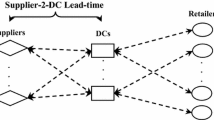Abstract
Recently, substantial progress has been made in developing efficient algorithms for solving combinatorial optimization problems. In this paper, following this direction, the problem of designing supply chains which is an important combinatorial optimization problem is considered. The structural properties of supply chain models are investigated to transform such models into a generalized network optimization model. The transformation to a generalized network optimization model reduces the algorithms' solution time. Moreover, this paper proposes a new efficient hybrid algorithm based on tabu search and generalized network simplex algorithm (GN-TSA) for designing multi-objectives supply chain models. The developed algorithm's parameters are tuned properly, validated, and evaluated. The algorithm's performance is then compared to an exact algorithm embedded in the General Algebraic Modeling System (GAMS) and two metaheuristic algorithms, namely a linear programming simplex algorithm integrated with the tabu search approach (LP-TSA) and simulated annealing. The findings indicated that the GN-TSA obtains solutions very close to the exact algorithm with less computation time. In addition, the proposed algorithm outperforms the LP-TSA and simulated annealing in terms of computation time, while the quality of the solutions is the same as solutions obtained by LP-TSA and better than simulated annealing. On average, the results revealed that the reduction in computational time is more than 26.30% using GN-TSA compared to LP-TSA and simulated annealing.



Similar content being viewed by others
References
Ahuja RK, Magnanti TL, Orlin JB (1993) Network flows: theory, algorithms, and applications. Prentice-Hall
Altiparmak F, Gen M, Lin L, Paksoy T (2006) A genetic algorithm approach for multi-objective optimization of supply chain networks. Comput Ind Eng 51(1):196–215
Arabzad SM, Ghorbani M, Tavakkoli-Moghaddam R (2015) An evolutionary algorithm for a new multi-objective location-inventory model in a distribution network with transportation modes and third-party logistics providers. Int J Prod Res 53(4):1038–1050
Bandyopadhyay S, Bhattacharya R (2014) Solving a tri-objective supply chain problem with a modified NSGA-II algorithm. J Manuf Syst 33(1):41–50
Bazaraa MS, Jarvis JJ, Sherali HD (2008) Linear programming and network flows. Wiley
Bevilacqua V, Costantino N, Dotoli M, Falagario M, Sciancalepore F (2012) Strategic design and multi-objective optimization of distribution networks based on genetic algorithms. Int J Comput Integr Manuf 25(12):1139–1150
Che ZH, Chiang CJ (2010) Advances in engineering software a modified pareto genetic algorithm for multi-objective build-to-order supply chain planning with product assembly. Adv Eng Soft 41(7–8):1011–1022. https://doi.org/10.1016/j.advengsoft.2010.04.001
Dede T, Grzywiński M, Rao RV (2020) Jaya: a new meta-heuristic algorithm for the optimization of braced dome structures in advanced engineering optimization through intelligent techniques. Springer
Devika K, Jafarian A, Nourbakhsh V (2014) Designing a sustainable closed-loop supply chain network based on triple bottom line approach: a comparison of metaheuristics hybridization techniques. Eur J Oper Res 235(3):594–615
Dzupire NC, Nkansah-Gyekye Y (2014) A multi-stage supply chain network optimization using genetic algorithms. Math Theory Model 4(8):18–29
Eskandarpour M, Zegordi SH, Nikbakhsh E (2013) A parallel variable neighborhood search for the multi-objective sustainable post-sales network design problem. Int J Prod Econ 145(1):117–131
Fallah-Tafti AL, Sahraeian R, Tavakkoli-Moghaddam R, Moeinipour M (2014) An interactive possibilistic programming approach for a multi-objective closed-loop supply chain network under uncertainty. Int J Syst Sci 45(3):283–299
Farahani RZ, Elahipanah M (2008) A genetic algorithm to optimize the total cost and service level for just-in-time distribution in a supply chain. Int J Prod Econ 111(2):229–243
Govindan K, Jafarian A, Khodaverdi R, Devika K (2014) Two-echelon multiple-vehicle location–routing problem with time windows for optimization of sustainable supply chain network of perishable food. Int J Prod Econ 152:9–28
Govindan K, Jafarian A, Nourbakhsh V (2015) Bi-objective integrating sustainable order allocation and sustainable supply chain network strategic design with stochastic demand using a novel robust hybrid multi-objective metaheuristic. Comput Oper Res 62:112–130
He B, Yang C, Ren M (2007) A fuzzy multi-objective programming for optimization of reverse logistics for solid waste through genetic algorithms. In: Fourth international conference on fuzzy systems and knowledge discovery (FSKD 2007), pp 416–420. https://doi.org/10.1109/FSKD.2007.37
Houssein EH, Saad MR, Hashim FA, Shaban H, Hassaballah M (2020) Lévy flight distribution: a new metaheuristic algorithm for solving engineering optimization problems. Eng Appl Artif Intell 94:103731
Kaveh A, Zaerreza A (2020) Shuffled shepherd optimization method: a new Meta-heuristic algorithm. Eng Comput 37:2357
Kaur S, Awasthi LK, Sangal AL (2020) HMOSHSSA: a hybrid meta-heuristic approach for solving constrained optimization problems. Eng Computers 56:1–37
Khalilpourazari S, Naderi B, Khalilpourazary S (2020) Multi-Objective Stochastic Fractal Search: a powerful algorithm for solving complex multi-objective optimization problems. Soft Comput 24(4):3037–3066
Kirkpatrick S, Gelatt CD, Vecchi MP (1983) Optimization by simulated annealing. Science 220:671–680
Lee D-H, Bian W, Dong M (2007) Multiobjective model and solution method for integrated forward and reverse logistics network design for third-party logistics providers. Trans Res Record J Trans Res Board 2032(1):43–52. https://doi.org/10.3141/2032-06
Mirakhorli A (2014) Fuzzy multi-objective optimization for closed-loop logistics network design in bread-producing industries. Int J Adv Manuf Technol 70(1–4):349–362
Melo MT, Nickel S, Saldanha-Da-Gama F (2012) A tabu search heuristic for redesigning a multi-echelon supply chain network over a planning horizon. Int J Prod Econ 136(1):218–230
Montgomery DC, Runger GC, Hubele NF (2009) Engineering statistics. John Wiley & Sons
Murata T, Ishibuchi H, Tanaka H (1996) Multi-objective genetic algorithm and its applications to flowshop scheduling. Comput Indus Eng 30(4):957–968. https://doi.org/10.1016/0360-8352(96)00045-9
Pasandideh SHR, Niaki STA, Asadi K (2015) Bi-objective optimization of a multi-product multi-period three-echelon supply chain problem under uncertain environments: NSGA-II and NRGA. Inf Sci 292:57–74
Pishvaee MS, Farahani RZ, Dullaert W (2010) A memetic algorithm for bi-objective integrated forward/reverse logistics network design. Comput Op Res 37(6):1100–1112
Qiao W, Yang Z (2019) Solving large-scale function optimization problems by using a new metaheuristic algorithm based on quantum dolphin swarm algorithm. Ieee Access 7:138972–138989
Rodger JA (2014) Application of a fuzzy feasibility Bayesian probabilistic estimation of supply chain backorder aging, unfilled backorders, and customer wait time using stochastic simulation with Markov blankets. Expert Syst Appl 41:7005–7022
Sadigh AN, Fallah H, Nahavandi N (2013) A multi-objective supply chain model integrated with location of distribution centers and supplier selection decisions. Int J Adv Manuf Techol 69:225–235
Sahu NCHS (2013) Multi objective outbound logistics network design for a manufacturing supply chain. J Intell Manuf 25:1071–1084
Shankar BL, Basavarajappa S, Kadadevaramath RS, Chen JC (2013) A bi-objective optimization of supply chain design and distribution operations using non-dominated sorting algorithm: a case study. Expert Syst Appl 40(14):5730–5739
Validi S, Bhattacharya A, Byrne PJ (2014) A case analysis of a sustainable food supply chain distribution system - a multi-objective approach. Int J Prod Econ 152:71–87
Xu J, Liu Q, Wang R (2008) A class of multi-objective supply chain networks optimal model under random fuzzy environment and its application to the industry of Chinese liquor. Inf Sci 178(8):2022–2043
Yang G-Q, Liu Y-K, Yang K (2015) Multi-objective biogeography-based optimization for supply chain network design under uncertainty. Comput Ind Eng 85:145–156
Yapici H, Cetinkaya N (2019) A new meta-heuristic optimizer: Pathfinder algorithm. Appl Soft Comput 78:545–568
Yu M, Goh M (2014) A multi-objective approach to supply chain visibility and risk. Eur J Oper Res 233(1):125–130
Acknowledgements
The authors express their gratitude to the King Fahd University of Petroleum and Minerals for supporting this work. The authors would thank with gratitude two anonymous referees for their valuable comments that improved the quality of the paper.
Author information
Authors and Affiliations
Corresponding author
Ethics declarations
Conflict of interests
The authors declare there are no conflict of interests.
Additional information
Publisher's Note
Springer Nature remains neutral with regard to jurisdictional claims in published maps and institutional affiliations.
Appendix
Appendix




Rights and permissions
Springer Nature or its licensor holds exclusive rights to this article under a publishing agreement with the author(s) or other rightsholder(s); author self-archiving of the accepted manuscript version of this article is solely governed by the terms of such publishing agreement and applicable law.
About this article
Cite this article
Mohammed, A., Duffuaa, S.O. A hybrid algorithm based on tabu search and generalized network algorithm for designing multi-objective supply chain networks. Neural Comput & Applic 34, 20973–20992 (2022). https://doi.org/10.1007/s00521-022-07573-y
Received:
Accepted:
Published:
Issue Date:
DOI: https://doi.org/10.1007/s00521-022-07573-y




